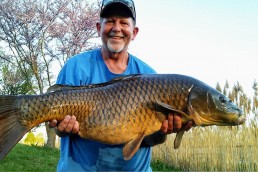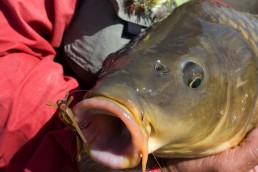Do You Fish for Carp?
SHARE THIS POST
Some people don’t understand why a guy would want to go fishing for carp. “Carp?” they say. “What do you do with them?” I tell them, “Well, it’s no different than what you would do with a bass—CPR (catch, photo and release).”
I had been a bass fisherman for over 25 years, mainly fishing out of a belly boat at Mazonia, a series a strip pits owned by the State of Illinois. During spring and fall, I would chase crappies as well. When summer came, it was time to wade the Kankakee River. I did that for 20-plus years, too, chasing smallmouth bass and catfish. I loved doing both, but I believe both of these hobbies contributed to each of my hips needing to be replaced. Wading and belly boating started to hurt more and more. I was at a crossroads in my fishing life. Then I met Jim Snyder and he took me carp fishing.
Jim had switched to carp fishing a couple of years before I had met him. We were going to use his rods and tackle. He had already purchased a large net, a weigh sling, an unhooking mat to keep the carp from getting hurt, and a scale to weigh our catches. It was nice to have someone giving directions when I had no idea what I was doing. Like any fish species, YouTube has numerous carp fishing tutorials available, in case you don’t have a personal guide available to you.
Jim took me to a local strip mine club where he belonged. It was a blast! I can’t remember how many fish Jim had for sure; he caught plenty, but I caught 10 fish with the biggest carp being just over 10 pounds. I was in heaven—a 10-pounder! After all those years of bass fishing, the biggest bass I had caught was a 7-pound, 13-ounce largemouth from Mazonia.
I was hooked! It was all new; it was exciting; and it was the beginning of a passion that I hadn’t felt in my years of bass fishing.
It took some time to learn the new methods of carp fishing and to acquire the needed equipment. Typically, we fish European style, using “feeders” to hold a combination of sweet corn, breadcrumbs and oats, called pack bait, attached to a baited hair rig.
We use Bait Runner spinning reels, which allow the carp to peel line off the reel during the initial run, instead of pulling the rod in the water. The pack bait attracts the carp, and hopefully the carp will then want to eat the offerings presented on the hair.
The excitement starts with a run. The carp, once it feels the hook sink in its mouth, will take off in a flash, peeling line off of the reel. To add to this hysteria, the rods are sitting on a “bite alarm” that detects the smallest of line movement with a loud beep. When line is pulling out of the reel, the alarms are screaming! It is so exciting when a run comes.
Are you enjoying this post?
You can be among the first to get the latest info on where to go, what to use and how to use it!
Unlike bass fishing baits, carp fishing baits can be made yourself and out of many different items. Carp bait is a lot cheaper than buying bass lures that can be lost on any given cast. I commonly use cooked field corn, homemade cooked dough balls called “boilies,” tiger nuts and plastic corn to name a few common baits. Carp can be caught on almost anything edible. There is also a wide range of store-bought carp baits available as well. Check out eBay for the widest selection.
But don’t think that you will automatically go catch one. Carp can get spooked very easy and can be as fickle as any gamefish to catch. But, when it’s on, look out. Carp can be caught rather quickly when they are biting. My highest one-day catch total is 43 carp, with several days catching 20 or more. Getting a double—two at once—can be extra challenging, as these fish are superior fighters and fight way harder than most fish.
The size of the carp is what makes fishing for them so much fun. In 2019, I managed 20 carp over 20 pounds, with a new personal best of 26.8 pounds. Bigger better, and more fun, too.
One thing to keep in mind is that all the lakes you had previously ruled out for bass and panfish, now have to be reconsidered for carp fishing. You used to look for a boat ramp, but now you are looking for bank space. Huge carp can live in smaller bodies of water, as well as large ones. These fish have grown uncontested due to next-to-no fishing pressure. This is exciting, living in central Illinois, where good fishing lakes are hard to come by. Just because a lake was no good for bass, does not mean it won’t be great for carp.
There are some other types of fish that are sought after by carp fishermen as well. There are grass carp, buffalo, koi, mirror carp, fan tail carp and ghost carp. These types of fish are not available in all waters, which makes traveling to different locations fun.
During my 2 1/2 years fishing for carp, I have met many new friends, learned new techniques and fished in bodies of water I otherwise would not have visited. Fishing for carp is like fishing for any other species of fish—you are constantly trying to figure out how and where to catch them. So, if you are getting bored in the Midwest, catching small bass and panfish, take some time to learn about carp fishing. It may be the adrenalin rush you are looking for. I know it was for me!
For more information…
To learn how to tie a simple carp rig, go to youtube.com/watch?v=UcPa2j089T4
MWO
SHARE THIS POST
Did you enjoy this post?
You can be among the first to get the latest info on where to go, what to use and how to use it!



